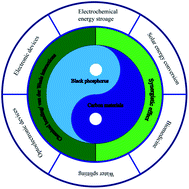Recent advances in black phosphorus/carbon hybrid composites: from improved stability to applications
Abstract
As a “hot” member of two-dimensional (2D) materials, black phosphorus (BP) has received growing interest in a variety of fields in physics, chemistry, materials, and biomedicine since 2014. Owing to the exclusive 2D layered structure, some fantastic properties such as tunable band structure, high charge mobility, and in-plane anisotropy provide BP with great potential for application in electronic/optoelectronic devices, energy source conversion and storage, etc. However, with in-depth investigations, the performance deficiencies of BP-based devices are exposed, originating from the poor chemical stability of BP. To address the above issues, a variety of BP/carbon hybrid composites have been constructed as an emerging type of multifunctional materials by the integration of the unique properties of carbon materials with the merits of BP into a single hybrid heterostructure, showing improved performance for applications. In this review, the enhanced stability of BP is presented based on the fundamental chemistry of BP degradation, which originates from the formation of P–C/P–O–C bonds or van der Waals interactions in BP/carbon hybrid composites. Recent research studies focusing on the utilization of BP/carbon hybrid composites for electrochemical energy storage, photocatalytic hydrogen production and optoelectronic devices are summarized, in which approaches toward the assembly of BP/carbon hybrid composites are introduced. Finally, the extant challenges and potential applications of BP/carbon hybrid materials are also proposed.

- This article is part of the themed collection: Journal of Materials Chemistry A Recent Review Articles


 Please wait while we load your content...
Please wait while we load your content...